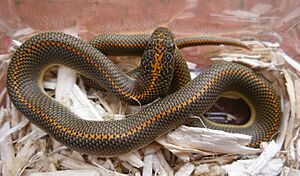Aurora house snake facts for kids
Quick facts for kids Aurora house snake |
|
|---|---|
 |
|
| Conservation status | |
| Scientific classification | |
| Genus: |
Lamprophis
|
| Species: |
aurora
|
| Synonyms | |
|
Coluber Aurora Linnaeus, 1758 |
|
The Aurora house snake is a beautiful snake found in Southern Africa. It is also known as the Aurora snake, African house snake, or night snake. Its scientific name is Lamprophis aurora. This snake is not venomous, meaning it is harmless to humans. It lives only in certain parts of Southern Africa, including South Africa, Lesotho, Eswatini, and Botswana.
Contents
Where Does the Aurora House Snake Live?
This type of house snake is found in many places across South Africa. You can find it in almost all provinces there. It also lives in Lesotho, Eswatini, and parts of eastern Botswana. Sometimes, animals can be moved to new areas by humans, which is called translocation. This might be how some Aurora house snakes ended up in eastern Botswana.
What Does the Aurora House Snake Look Like?
The Aurora house snake can grow to be about 90 centimeters (about 3 feet) long. However, most of them are usually between 45 and 60 centimeters (about 1.5 to 2 feet) long. Their bodies can be a shiny olive green or a dull dark green color. A bright yellow or orange stripe runs down their back. This stripe goes all the way from the top of their head to the tip of their tail.
Where Do They Live and What Do They Do?
Their Home Environment
Aurora house snakes like to live in different kinds of places. They can be found in grasslands, a special plant area called fynbos, and moist savanna habitats. They live in areas up to 1,700 meters (about 5,577 feet) above sea level. You can often find them near streams or hiding under rocks. Sometimes, they even live inside old termite mounds.
Daily Life and Diet
These snakes are quite shy and like to stay hidden. Even though they are secretive, they can be common in places where they like to live. They are active at night, which means they are nocturnal. During the day, they usually rest. Their diet includes small animals like rodents (such as mice), lizards, and frogs.
Reproduction and Behavior
Female Aurora house snakes lay eggs. They can lay up to 12 eggs in one group, which is called a clutch. Since these snakes are not venomous, they are not dangerous to people. They also rarely try to bite, even if you come across one.
Are They Safe?
The places where Aurora house snakes live, like grasslands, are often changed by people. These changes happen because of cities growing and farms being built. However, the Aurora house snake is not considered to be in danger. This is because they are still common in good habitats and live in many different areas. Their homes also overlap with several protected areas, which helps keep them safe.


